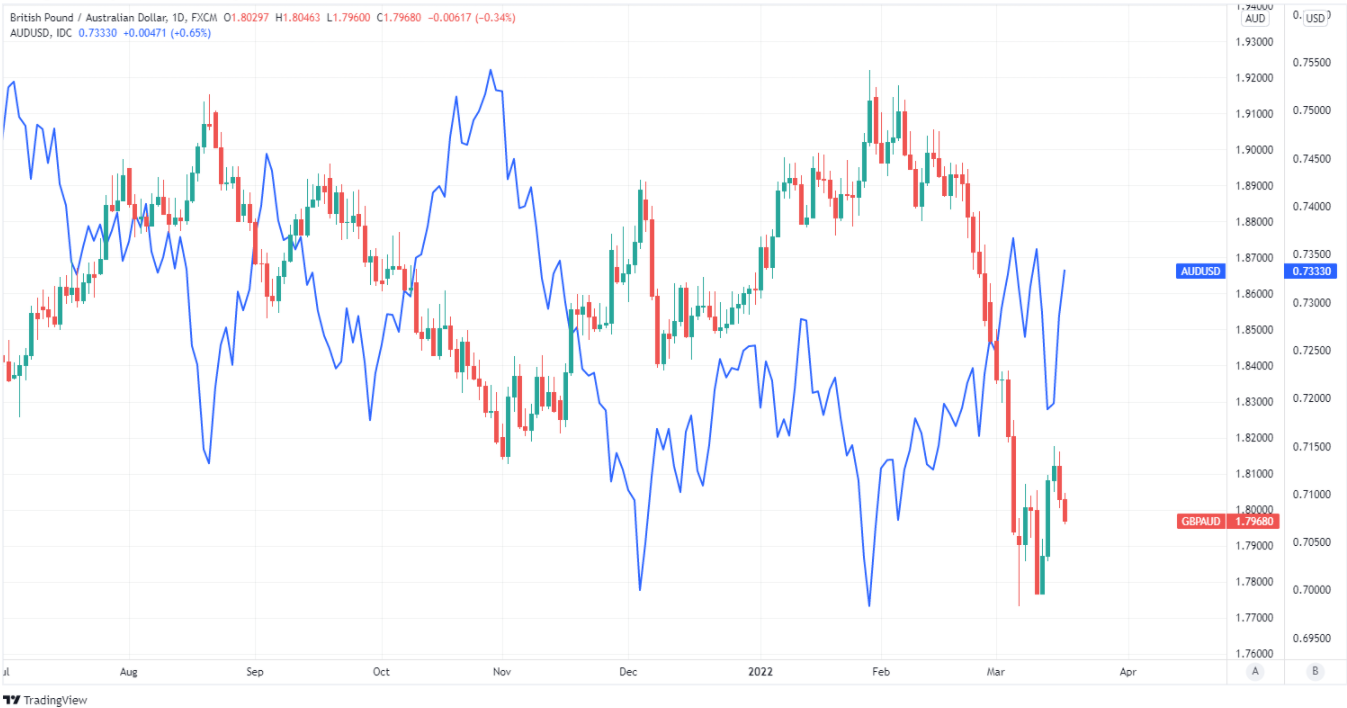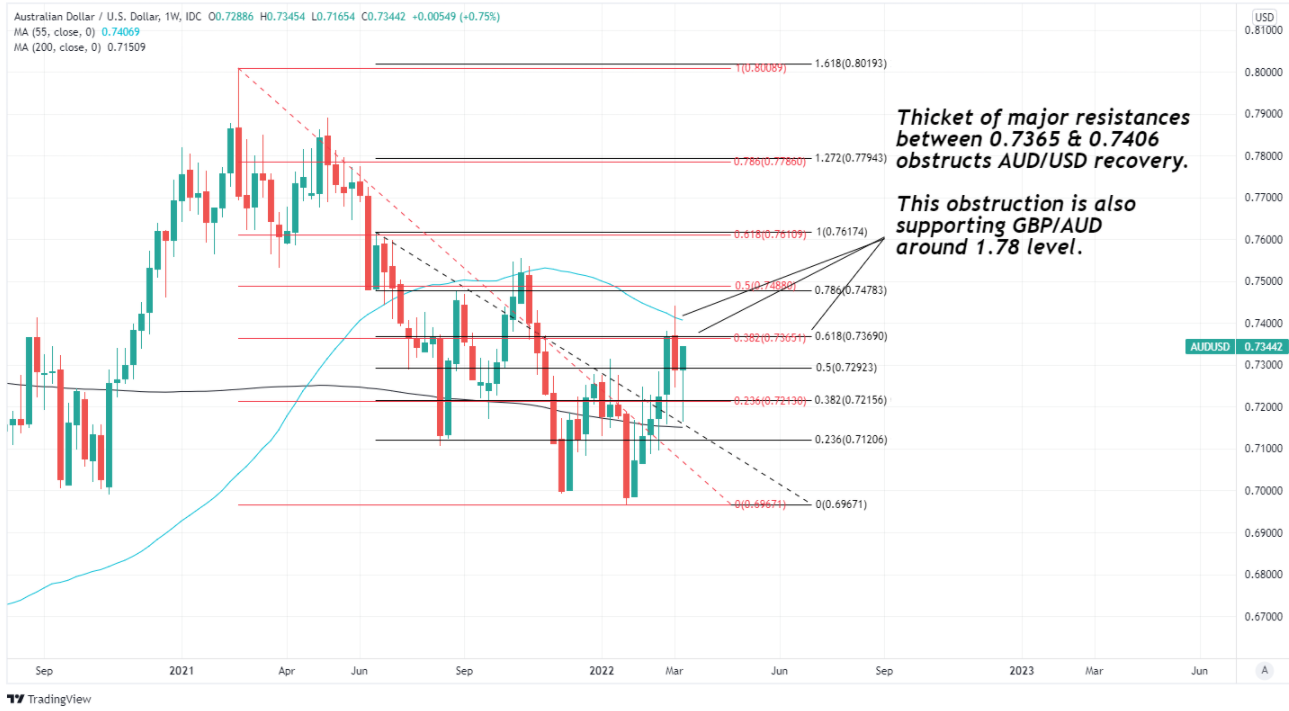Pound / Australian Dollar Rate Slipping Back toward 1.78
- Written by: James Skinner
- AUD/USD’s gains see GBP/AUD ebb lower
- After data shows AU job market blooming
- Possible implications for RBA’s rate policy
- BoE may hamper GBP/AUD in days ahead
- May see GBP/AUD head for retest of 1.78

Image © Adobe Images
The Pound to Australian Dollar rate was ebbed lower on Thursday after the antipodean currency was lifted by further signs of a blossoming labour market down under, although GBP/AUD could potentially slip further still if the Bank of England (BoE) weighs on Sterling in the days ahead.
Australia’s Dollar rose against all major currencies in the penultimate session of the week after Australian Bureau of Statistics data showed the unemployment rate falling to 4% in February and its lowest since August 2008.
The jobless figure reached its lowest level since before the 2008 collapse of Lehman Brothers and resulting financial crisis even with the overall employment rate still running beneath its mid-2021 highs, indicating that it could fall further still in the months ahead.
“The February labour force survey was an incredibly strong set of numbers,” says Gareth Aird, head of Australian economics at Commonwealth Bank of Australia, who sees the data supporting CBA’s forecast for an Australian interest rate rise in June this year.
“The 77.4k increase in employment was significantly bigger than the market consensus of 37.0k (CBA above consensus at 40k; we had flagged that the risk lay with a stronger print). Employment is up by 4.1% over the year and sits 4.0% above its pre‑pandemic level,” Aird also said on Thursday.
Above: Pound to Australian Dollar rate shown at daily intervals alongside AUD/USD.
- GBP to AUD reference rates at publication:
Spot: 1.7970 - High street bank rates (indicative band): 1.7340-1.7468
- Payment specialist rates (indicative band): 1.7809-1.7850
- Find out about specialist rates, here
- Set up an exchange rate alert, here
If anything, the implication of Thursday’s data is that it could potentially lead the Reserve Bank of Australia (RBA) to further soften its commitment to maintaining its cash rate at the current historic low of 0.10%.
So far the RBA has said repeatedly it would keep borrowing costs where they are until employment and pay growth for workers have risen sufficiently for the two-to-three percent inflation target to be met over the medium-term.
“We have scope to wait and assess incoming information and see how some of the uncertainties are resolved. We can be patient in a way that countries with substantially higher rates of inflation cannot,” Governor Philip Lowe told the AFR Business Summit on March 09.
Although the RBA has recently acknowledged that it’s “plausible” that borrowing costs could rise this year, these statements have also been heavily caveated while Governor Lowe has said three times in March that the bank can afford to be patient before raising interest rates.
{wbamp-hide start}
{wbamp-hide end}{wbamp-show start}{wbamp-show end}
“The Reserve Bank has indicated full employment is consistent with an unemployment rate around the high 3s or low 4s. The jobless rate is now well into this territory. Given this, we expect wage pressures will build more materially, shortening the odds for an August rate hike, or possibly sooner,” says Matthew Bunny, an economist at St George Bank.
The idea behind the RBA’s stance is that the longer such a decision is delayed for, the more time Australia’s labour market will have in order to blossom, although many economists are growing increasingly confident in forecasts that RBA interest rates could begin to rise in either June or August this year.
That’s a supportive factor that may have played a role in driving the Australian Dollar’s outperformance on Thursday, which pulled the Pound to Australian Dollar exchange rate lower despite Sterling also rising against many currencies ahead of the March Bank of England policy decision.
While the BoE is widely expected to lift Bank Rate back to its pre-coronavirus crisis level of 0.75% on Thursday, there is a risk of the Pound to Australian Dollar rate’s losses deepening ahead of the weekend if language contained in the bank’s policy statement seeks to dissuade financial markets of recently mounting expectations for the UK benchmark to rise as far as 2% this year.
Above: AUD/USD shown at weekly intervals with Fibonacci retracements of June 2021 and February 2021 downtrends indicating areas of likely technical resistance to an Australian Dollar recovery, shown alongside 55-week and 200-week moving-averages.







